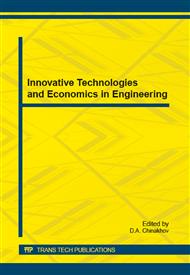p.174
p.178
p.183
p.188
p.192
p.196
p.202
p.206
p.210
Loading of the Manufacturing Systems Elements in the Process of Unsteady Mode Cutting and the Models of their Arrangement Deviations
Abstract:
To improve the treatment accuracy by on-line correction of the paths of the executive working parts (EWP) the authors study the processes of loading, deformation and arrangement deviation of the elements of the manufacturing systems (MS) under the changes of the cutting force components in the process of turning on machine-tools equipped with CNC systems of PCNC class. Estimation of the values of the technological components of the cutting force Px, Py, Pz is based on the phenomenon of arrangement deviation Δωi of the elements monitoring the servo drives of machine tools. To determine the compliance of the deviation magnitude Δwi with the technological components of the cutting force Px, Py a diagnostic subsystem was developed, involving the loading devices and dynamometric equipment. The diagnostic system is controlled through PCNC with the application of a specially developed hardware-software system. The data on changes in the values Px, Py and the respective changes in the attitude misalignment parameters in servo drives at various EWP minute feeds in CNC machine tools were determined by prior diagnosis of load characteristics servo drives, registered in the PCNC. So, the data of cutting force components Px, Py compliance with arrangement error ratios ΔωXп , ΔωZп. were established.
Info:
Periodical:
Pages:
192-195
Citation:
Online since:
October 2014
Authors:
Price:
Сopyright:
© 2014 Trans Tech Publications Ltd. All Rights Reserved
Share:
Citation:


